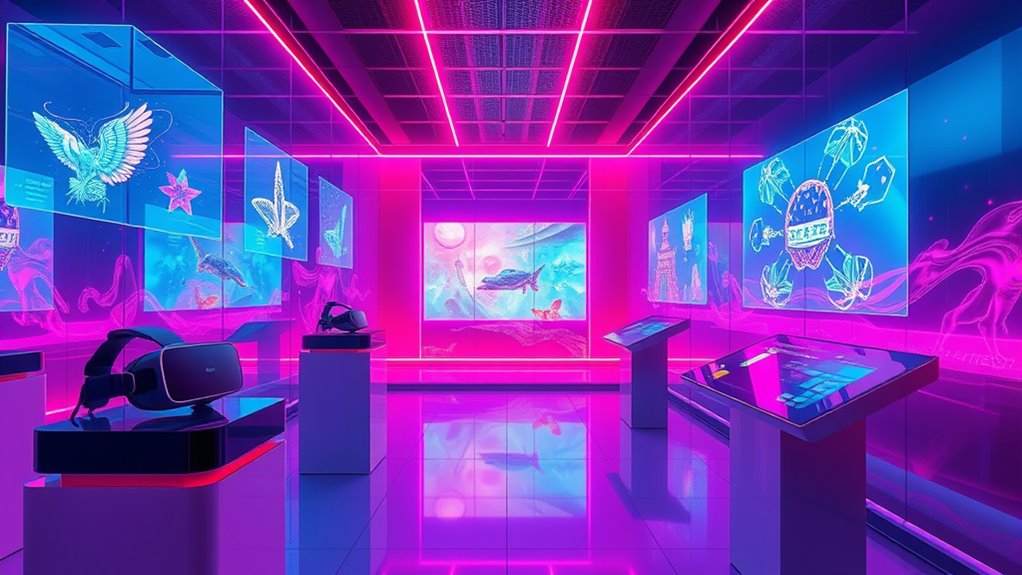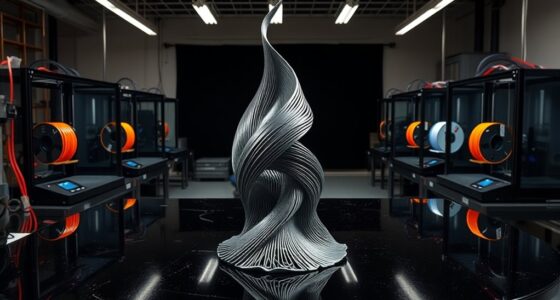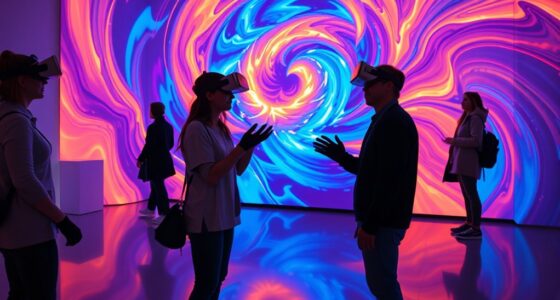Virtual exhibitions are revolutionizing how you experience and access art. They break down geographical barriers, letting you explore artworks anytime and anywhere. Interactive features like VR, AR, and AI make exhibitions immersive and personalized, deepening your connection with the pieces. Digital platforms also offer cost-effective ways for artists and galleries to expand their reach and build global communities. If you continue exploring, you’ll discover how these innovations guarantee art’s survival and growth in the online world.
Key Takeaways
- Virtual exhibitions break geographical barriers, making art accessible worldwide and fostering inclusive cultural exchange.
- Digital platforms enable 24/7 artwork exploration, increasing visibility and engagement beyond traditional gallery hours.
- Immersive technologies like AR, VR, and AI enhance interactive experiences, deepening emotional connections with art.
- Online sales, virtual tours, and memberships diversify revenue streams while reducing costs related to physical venues.
- AI and digital innovations personalize experiences, analyze data, and expand curatorial possibilities, ensuring art remains dynamic online.
The Rise of Digital Platforms in the Art World

Have you noticed how digital platforms are transforming the art world? Today, online art sales are projected to surpass $12 billion in 2025, making digital channels more essential than ever. Platforms like Instagram, Artsy, and Saatchi Art democratize access, allowing artists to reach global audiences without traditional gallery representation. Over 55% of galleries are increasing digital content and virtual exhibitions, expanding their reach and engagement. Young collectors under 40 are discovering artists online—62% of them—while 38% make purchases through digital channels. This shift is driven by the convenience of browsing, instant sharing, and buying. Digital platforms break down geographical barriers, giving emerging artists visibility and collectors access to a vast, diverse array of artworks. The digital art market is projected to reach US$ 17.72 billion by 2032, and technology is truly reshaping how art is discovered, bought, and experienced. As the digital transformation continues, more artists and collectors are embracing online avenues for engagement and commerce. Additionally, innovations in virtual and augmented reality are creating immersive experiences that further enhance online art engagement. The growth of online art marketplaces also supports artists in reaching wider audiences and selling their work directly. Moreover, digital art platforms are increasingly integrating blockchain technology, providing secure ownership and provenance verification, which adds trust and transparency to online transactions.
Expanding Reach Through Virtual Exhibitions

Virtual exhibitions let you connect with a global audience, removing geographical barriers and expanding your reach. With interactive features and round-the-clock access, your work becomes more visible and engaging for diverse viewers. This approach opens new opportunities for recognition, sales, and collaborations worldwide. The market growth is driven by increasing digital adoption and innovative technologies like AR, VR, and AI, making virtual showcases more immersive and accessible than ever before. Incorporating digital diversification strategies further enhances the visibility and impact of your virtual exhibit, attracting a broader audience and increasing engagement. Additionally, integrating pediatric sleep training methods can help new parents and artists alike better manage their energy and focus during demanding periods. Recognizing the importance of visual presentation can significantly improve how your art resonates with online viewers. Staying informed about IRA Investment Strategy can also inspire creative ways to fund and support your virtual exhibitions sustainably. Moreover, understanding celebrity transformations can inspire innovative ways to showcase art evolution and personal growth within virtual platforms.
Global Audience Access
Ever wondered how art can reach audiences worldwide without leaving their homes? Virtual exhibitions make this possible by breaking down geographical barriers, giving you access to global masterpieces anytime you want. You no longer need to travel or wait for physical gallery hours—you can explore art at your convenience, 24/7. This expanded reach benefits artists and galleries by increasing exposure to diverse audiences, including younger viewers and those who might not typically visit traditional spaces. Plus, virtual setups are more cost-effective, reducing expenses for both creators and visitors. As technology advances, more immersive experiences and personalized recommendations enhance your engagement even further. With virtual exhibitions, your access to art becomes limitless, connecting you to cultures and creative expressions from around the world. Online exhibitions connect artists and galleries to a global audience, making art more accessible than ever before. These digital platforms also allow for detailed artwork analysis and educational opportunities that enhance understanding and appreciation. Additionally, integrating psychological research into virtual curation can foster deeper emotional connections with the artwork. Moreover, leveraging digital tools can help simulate the tactile experience of viewing art in person, enriching your overall experience. Embracing immersive technology can further transform virtual art spaces into more engaging and realistic environments, enhancing viewer immersion. Furthermore, ongoing technological innovations continue to expand the possibilities for virtual art experiences, ensuring they remain dynamic and engaging for audiences worldwide.
Interactive Engagement Opportunities
Interactive engagement opportunities are transforming how audiences connect with digital exhibitions by fostering active participation. Immersive experiences like VR installations allow you to shape your journey through the art, making each visit unique. These technologies tap into motivational domains such as social contact and stimulus seeking, creating more meaningful connections. Interactive displays and neuro-stimulation enhance social interaction, making the experience more engaging and memorable. Studies show that 85% of visitors report a deeper bond with the artwork when actively involved. This approach transforms passive observation into active participation, encouraging you to influence and interpret art personally. By making art more dynamic and accessible, interactive opportunities broaden reach, deepen emotional connections, and redefine how audiences experience and appreciate art online. Immersive art integrates advanced technology to foster more personalized and impactful experiences for diverse audiences. Additionally, implementing accessible features ensures that virtual exhibitions are inclusive, allowing people with different abilities to engage fully. Engaging with AI-powered tools can further customize the experience, making virtual art exhibitions even more adaptable to individual preferences. Incorporating regular updates on hours and features can also keep visitors engaged and informed, enhancing their overall experience. Furthermore, understanding the importance of user engagement can help curators design more effective interactive elements that resonate with diverse audiences. Incorporating emerging digital trends enables virtual exhibitions to stay innovative and relevant in the fast-evolving landscape of online art experiences.
Enhancing Engagement With Interactive Technologies

As technology advances, museums and galleries are finding new ways to engage visitors more deeply through interactive features. Digital exhibitions now use sensors, touch screens, motion detection, and augmented reality (AR) to create immersive experiences that involve multiple senses. You shift from being a passive observer to an active participant, exploring art through real-time feedback and multisensory interactions. Virtual reality (VR) offers environments where you can navigate galleries and examine artworks in high detail, revealing hidden features. Personalized experiences adapt visual and audio elements based on your responses, fostering a sense of ownership and emotional connection. These technologies also promote accessibility, removing barriers for diverse audiences, including those with disabilities, by incorporating assistive tools like voice control and haptic feedback. The integration of interactive technologies not only enriches the visitor experience but also opens new possibilities for artistic expression and education. Additionally, digital content can be customized to suit different learning styles, making art more engaging and educational. Incorporating immersive environments further enhances engagement by providing supplementary information and multimedia elements that deepen understanding.
The Growing Influence of AI in Art Creation and Curation

AI is reshaping how art is created and curated, with its market share expected to hit 5% by 2025 and grow rapidly. As automated curation becomes more common in galleries and online platforms, questions about ethics and copyright laws are increasingly prominent. You’ll want to contemplate how these technological advances influence artistic authenticity and industry standards.
AI-Generated Art Trends
The influence of AI in art creation and curation is rapidly expanding, reshaping how artworks are produced, displayed, and valued. By 2025, AI-generated art is expected to make up 5% of the contemporary art market, reflecting growing collector interest and increasing exhibition numbers. Online communities are discussing AI art 50% more, and AI exhibitions have grown by 25% in recent years. Despite this momentum, 76% of people doubt AI works should be classified as art, and many artists worry about income impacts and outdated copyright laws. Still, high-value AI pieces like Edmon Belamy sell for hundreds of thousands, and over 34 million AI images are created daily. These trends highlight AI’s rising role in shaping the future of art, blending innovation with ongoing debates.
Automated Curation Processes
Artificial intelligence is transforming how museums and galleries organize and present their collections. You can see AI analyzing vast data sets—demographics, environmental factors, and historical context—to guide artwork selection and placement. Automated systems help curators make informed decisions, reducing bias and ensuring consistency, while also identifying pieces that resonate with community values and audience preferences. These algorithms assist in proactive collection management, suggesting preservation measures and timely conservation efforts. AI-driven tools analyze visitor data to optimize exhibition layouts and improve engagement. They also personalize experiences, tailoring recommendations to individual interests through virtual and augmented reality. By uncovering underrepresented artists and generating new exhibition concepts, AI expands curatorial possibilities, blending human creativity with machine intelligence for innovative, dynamic displays.
Ethical Considerations in AI
Have you ever wondered who truly owns a piece of art created by algorithms? You should know that legal ownership of AI-generated art is murky. Current laws don’t clearly define rights, leading to disputes over attribution—should credit go to the programmer, user, or AI? This ambiguity makes courts’ enforcement difficult. Many artists also feel existing copyright laws are outdated for AI art, which worries 89%. Public perception remains skeptical; most don’t see AI work as “real” art, though younger collectors show more openness. The growing AI art market, projected to reach $8.6 billion by 2033, raises concerns about job impacts and misinformation. Calls for regulation and transparency are essential to address ethical risks, ensuring AI art develops responsibly and fairly.
Navigating Economic Challenges With Online Strategies

Amid economic uncertainties, online strategies offer a vital path for arts organizations to sustain and grow. By leveraging digital platforms, you can reduce costs, expand reach, and diversify revenue streams. Virtual exhibitions eliminate expenses like shipping and venue overhead, enabling more flexible scheduling and longer displays. You can also monetize experiences through ticketed tours, memberships, and exclusive content, attracting a global audience. Additionally, digital tools facilitate direct art sales, bypassing traditional gallery commissions. To deepen your approach, consider this table:
| Strategy | Impact |
|---|---|
| Use AR/VR tech | Enhances visitor immersion, boosting engagement |
| Implement AI recommendations | Personalizes experiences, increasing sales |
| Incorporate blockchain | Ensures provenance, builds trust, and secures transactions |
Building Communities and Fostering Connections Virtually

How can virtual exhibitions effectively build communities and foster meaningful connections? By creating interactive virtual lobby spaces with user-friendly designs, you encourage visitors to explore and engage actively. Incorporating live sessions with artists or curators provides real-time opportunities for dialogue, deepening relationships. Open communication channels allow attendees to share feedback and ideas, making the experience more inclusive and responsive. Virtual platforms also facilitate cross-cultural exchanges, connecting diverse audiences worldwide and broadening perspectives. Networking features enable artists and viewers to connect beyond the exhibition, fostering collaborations. Additionally, integrating social media channels helps promote community interactions and extend conversations. When you prioritize accessibility, clear information, and engaging interactive elements, virtual exhibitions become more than viewing experiences—they transform into vibrant, connected communities.
Innovations in Virtual Reality and the Metaverse

Innovations in virtual reality (VR) and the metaverse are transforming how you experience and interact with art. VR headsets let you take immersive “walk-through” journeys through historical and contemporary scenes, making art feel immediate and alive. AR overlays add contextual details directly onto physical artworks, enriching your understanding. Multisensory installations combine visuals, sounds, touch, and scents to deepen emotional engagement. You can interact with digital art as if you’re physically present, exploring virtual galleries at your own pace. Artists are pushing creative boundaries by designing interactive installations and real-time collaborations within these spaces. As technology becomes more affordable and accessible, more people can enjoy high-quality virtual exhibitions from anywhere. This shift not only expands audience reach but also opens new avenues for artistic expression and engagement.
Future Trends Shaping the Online Art Market

The online art market is experiencing rapid growth driven by expanded sales channels, private transactions, and digital innovations. You’ll notice that 43% of galleries are focusing more on online sales to meet collector demand and attract new clients. In 2024, 59% of art buyers purchased online, with 73% increasing their digital purchases from the previous year. Private sales are also booming, offering discreet, flexible transactions that help navigate geopolitical and economic uncertainties. The digital artwork market is projected to grow from US$5.8 billion in 2025 to over US$17.7 billion by 2032, driven by AI, AR/VR, and NFTs. Plus, galleries plan to boost online content—think social videos, virtual shows, and artist interviews—to engage and retain a global, digitally-savvy audience.
Frequently Asked Questions
How Do Virtual Exhibitions Impact Traditional Gallery Sales and Foot Traffic?
Virtual exhibitions can boost your gallery sales by reaching a wider, global audience and reducing costs. They serve as valuable marketing tools that complement in-person visits, attracting new visitors and potential buyers. While online access increases exposure, it doesn’t replace the immersive experience of physically visiting your gallery. Overall, virtual exhibitions support your business by expanding your market and enhancing engagement without markedly decreasing foot traffic.
What Are the Main Ethical Concerns Surrounding Ai-Generated Art in Online Spaces?
You might notice AI-generated art raising ethical questions online, like unauthorized data scraping and lack of artist consent. When you see these works, consider how they often use protected art without permission, potentially infringing copyrights and devaluing human creativity. Many artists feel overlooked and unfairly compensated. As you engage with digital art, think about the importance of transparency, proper attribution, and developing ethical standards to protect artists’ rights.
How Can Emerging Artists Leverage Digital Platforms to Gain Visibility?
You can leverage digital platforms by consistently sharing your work on social media like Instagram and TikTok, using features like Reels and Stories to show your process. Join online galleries and marketplaces such as Artsy or Saatchi Art to reach wider audiences. Engage with younger collectors through virtual exhibitions and personalized interactions. Building a strong, professional online presence helps you stand out, attract followers, and boost your visibility in the digital art world.
What Are the Best Practices for Creating Immersive Virtual Art Experiences?
Imagine stepping into a vibrant, enchanted gallery where every color, texture, and sound immerses you. To create such an experience, you should customize your virtual space to match your theme, ensuring it’s accessible and easy to navigate. Incorporate interactive elements, multimedia, and live sessions to engage visitors deeply. Regularly gather feedback, optimize for mobile, and support the tech to keep your immersive exhibition enthralling and seamless.
How Will Virtual Reality Advancements Influence Future Art Consumption?
You’ll find that virtual reality advancements will transform how you experience art by making it more interactive and accessible. Instead of just observing, you’ll actively participate in immersive scenes, explore art from anywhere, and engage your senses. These innovations will foster global communities, introduce new art forms, and open up educational opportunities. As VR technology improves, your connection to art will deepen, creating richer, more personalized experiences.
Conclusion
As you embrace the evolving era of virtual exhibitions, remember that innovation ignites inspiration. By blending bold technology with boundless creativity, you can build bridges, boost engagement, and break barriers. The future fuels your fascination with fresh formats and fearless exploration. Stay spirited, stay inspired, and step confidently into this digital domain where art’s enduring essence endures, excites, and elevates—making every virtual visit a vibrant voyage.









